5 Integration With BPEL Service Components in the Oracle SOA Suite
Oracle Application Adapter for SAP R/3 integrates seamlessly with Business Process Execution Language (BPEL) Process Manager to facilitate Web service integration. Oracle BPEL Process Manager is based on the Service-Oriented Architecture (SOA). It consumes adapter services exposed as Web Service Definition Language (WSDL) documents.
This chapter includes the following topics:
Overview
To integrate with Oracle BPEL Process Manager, Oracle Application Adapter for SAP R/3 must be deployed in the same WLS container as Oracle BPEL Process Manager. The underlying adapter services must be exposed as WSDL files, which are generated during design time in Oracle Adapter Application Explorer (Application Explorer) for both request-response (outbound) and event notification (inbound) services of the adapter. See "Generating WSDL (J2CA Configurations Only)" for more information.
The generated WSDL files are used to design the appropriate BPEL processes for inbound or outbound adapter services. A completed BPEL process must be successfully compiled in JDeveloper and deployed to a BPEL server. Upon deployment to the BPEL server, every newly built process is automatically deployed to the Oracle Enterprise Manager console, where you run, monitor, and administer BPEL processes, and listen to adapter events.
Deployment of Adapter
During installation, Oracle Application Adapter for SAP R/3 is deployed as a J2CA 1.0 resource adapter within the WLS container. The adapter must be deployed in the same WLS container as Oracle BPEL Process Manager.
Configuring a New Application Server Connection
To configure a new Application Server connection in Oracle JDeveloper:
-
Open Oracle JDeveloper on your system.
-
From the menu bar, click View and select Application Server Navigator.
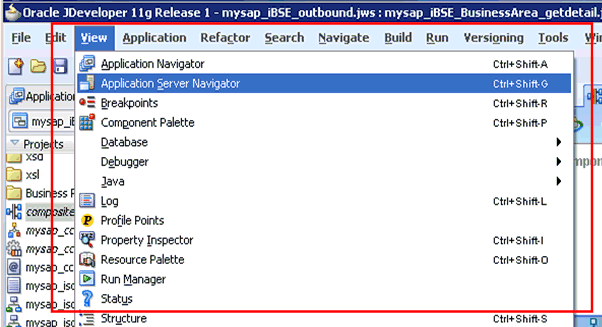
Description of the illustration config_appserver1.gif
The Application Server tab is displayed.
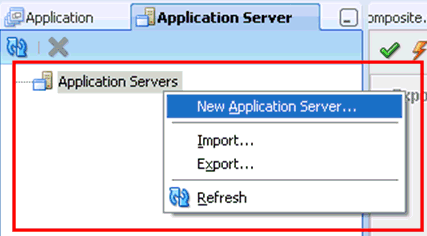
Description of the illustration config_appserver2.gif
-
Right-click Application Servers and select New Application Server.
The Create Application Server Connection Wizard is displayed.
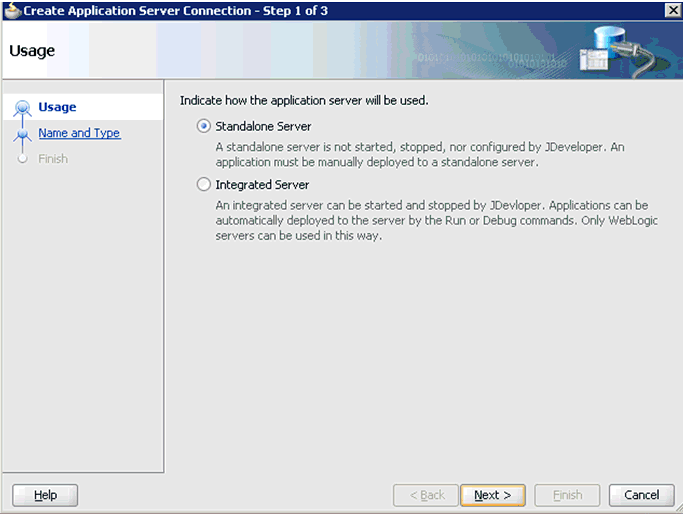
Description of the illustration config_appserver3.gif
-
Accept the default selection (Standalone Server) and click Next.
The Name and Type page is displayed.

Description of the illustration config_appserver4.gif
-
Specify a new name for the Application Server connection and click Next.
The Authentication page is displayed.

Description of the illustration config_appserver5.gif
-
Specify a valid user name (for example, weblogic) and a password (for example, welcome1) for your new connection.
-
Click Next.
The Configuration page is displayed.

Description of the illustration config_appserver6.gif
-
Specify the Oracle WebLogic host name (for example, localhost), which is the system IP where the process must deploy and Oracle WebLogic domain (for example, base_domain).
-
Click Next.
The Test page is displayed.
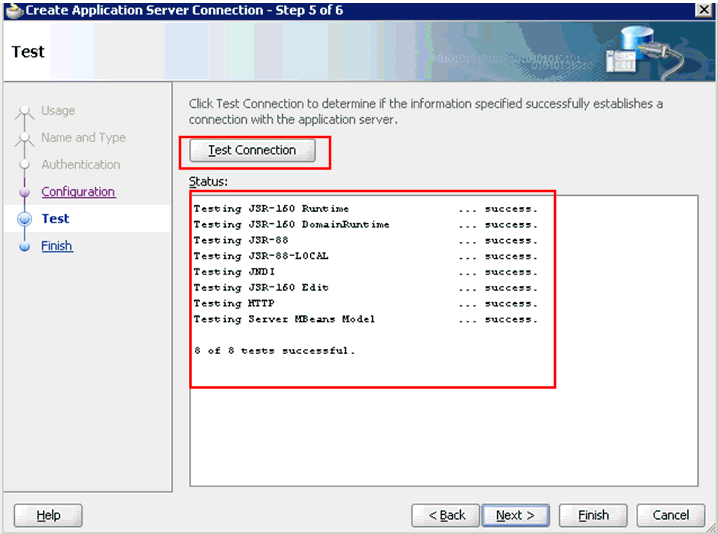
Description of the illustration config_appserver7.gif
-
Click Test Connection.
-
Make sure that the test status is successful.
-
Click Next.
The Finish page is displayed.

Description of the illustration config_appserver8.gif
-
Click Finish.
The new Application Server connection is listed in the left pane (Application Server tab), as shown in the following image.
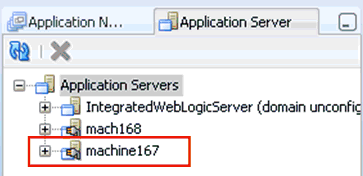
Description of the illustration config_appserver9.gif
Designing an Outbound BPEL Process for Service Integration
The following tools are required to complete your outbound design-time configuration:
-
Oracle Adapter Application Explorer (Application Explorer)
-
Oracle JDeveloper BPEL Designer (JDeveloper) or Eclipse
Note:
The examples in this chapter demonstrate the use of JDeveloper.Before you design a BPEL process, you must generate the respective WSDL file using Application Explorer. See "Generating WSDL for Request/Response Service" for more information.
Generating WSDL for Request/Response Service
Perform the following steps to generate a WSDL for request/response service:
-
Start Application Explorer and connect to a defined MySAP target (a J2CA configuration).
See "Defining a Target to SAP R/3" for more information on defining a target and connecting to SAP R/3.
-
Expand the MySAP target to which you are connected.
-
Expand Remote Function Modules, Financial Accounting, 0002 -- Company Code Business Object, and then select BAPI_COMPANYCODE_GETDETAIL.
The following image shows a connected and expanded target.

Description of the illustration app_exp_conn_target.gif
-
Right-click the BAPI_COMPANYCODE_GETDETAIL node.
The following menu is displayed:
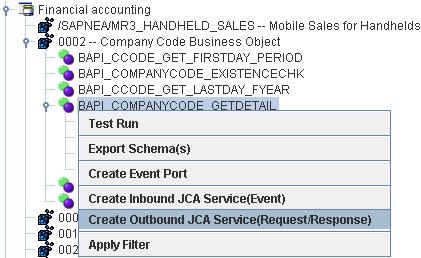
Description of the illustration bpel_40a.gif
-
Click Create Outbound JCA Service (Request/Response).
The Export WSDL dialog is displayed.

Description of the illustration bpel_41a_11g.gif
-
Click OK.
You can now create an empty composite for SOA, which is the first step that is required to define a BPEL outbound process in JDeveloper.
Creating an Empty Composite for SOA
Perform the following steps to create an empty composite for SOA:
-
Create a new SOA application.
-
Enter name for the new SOA Application and click Next.

Description of the illustration bpel_out_comp1.gif
The Name your project page is displayed.
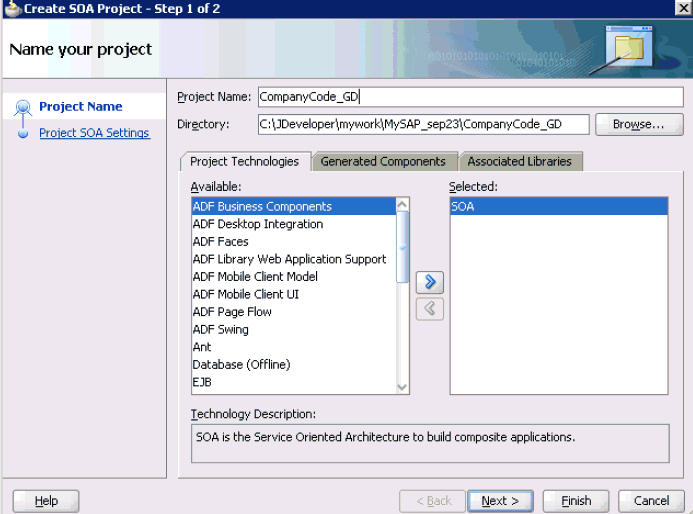
Description of the illustration bpel_out_comp2.gif
-
Enter a project name (for example, CompanyCode_GD) and click Next.
The Configure SOA settings page is displayed.
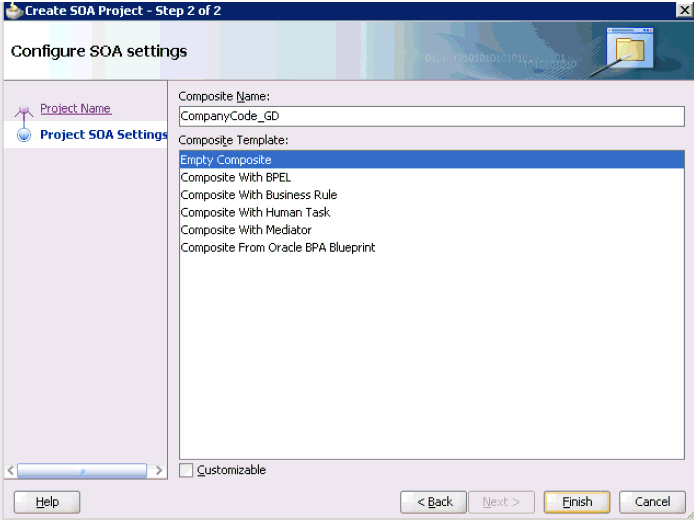
Description of the illustration bpel_out_comp3.gif
-
From the Composite Template list, select Empty Composite and click Finish.
Defining a BPEL Outbound Process
This section describes how to define a BPEL outbound process, which consists of the following stages:
-
Configuring a Third Party Adapter Service Component
-
Configuring an Outbound BPEL Process Component
Configuring a Third Party Adapter Service Component
Perform the following steps to create a third party adapter service component:
-
Drag and drop the Third Party Adapter component from the Service Adapters pane to the External References pane.

Description of the illustration bpel_out_adapt1.gif
The Create Third Party Adapter Service dialog is displayed.

Description of the illustration bpel_out_adapt2.gif
-
Enter a name for the third party adapter service.
-
Ensure that Reference is selected from the Type list (default).
-
Click the Find existing WSDLs icon, which is located to the right of the WSDL URL field.
The SOA Resource Browser dialog is displayed.
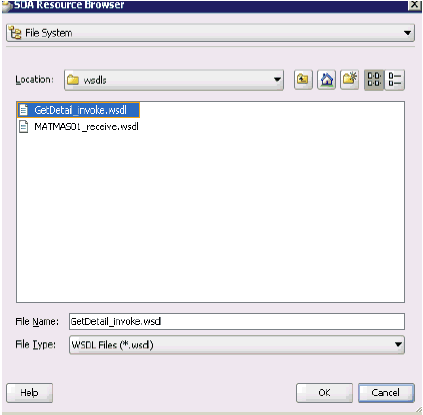
Description of the illustration bpel_out_adapt3.gif
-
Browse and select an outbound WSDL file from the following directory:
C:\oracle\Middleware\home_GA\Oracle_SOA1\soa\thirdparty\ApplicationAdapters\wsdls
-
Click OK.
The Localize Files dialog is displayed.
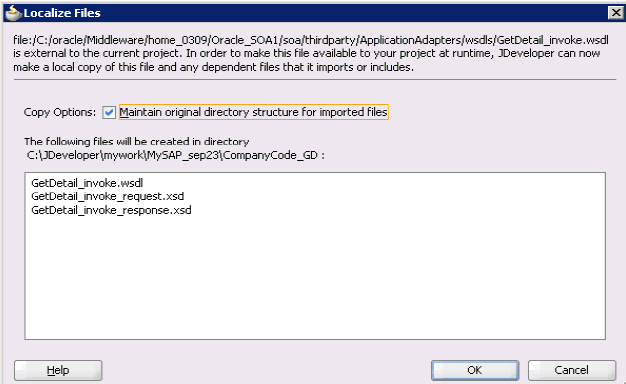
Description of the illustration bpel_out_adapt4.gif
-
Click OK.
The outbound WSDL file and associated request and response XML schema files (.xsd) are imported to the project folder that has been created.
You are returned to the Create Third Party Adapter Service dialog.
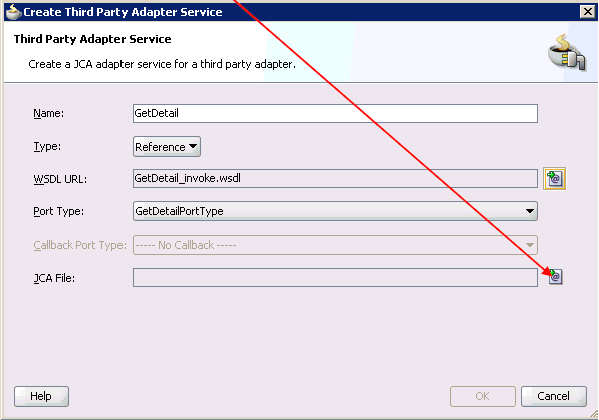
Description of the illustration bpel_out_adapt5.gif
-
Click the Find JCA file icon, which is located to the right of the JCA File field.
The SOA Resource Browser dialog is displayed.
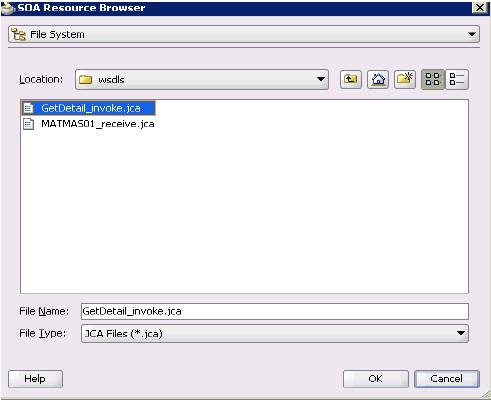
Description of the illustration bpel_out_adapt6.gif
-
Browse and select the JCA properties file from the following directory:
C:\oracle\Middleware\home_GA\Oracle_SOA1\soa\thirdparty\ApplicationAdapters\wsdls
-
Click OK.
The following message is displayed.
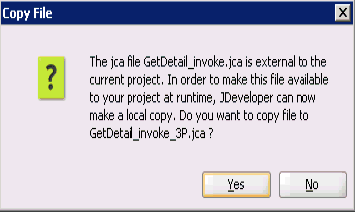
Description of the illustration bpel_out_adapt7.gif
-
Click Yes.
A copy of the JCA properties file is made in the project folder.
You are returned to the Create Third Party Adapter Service dialog.
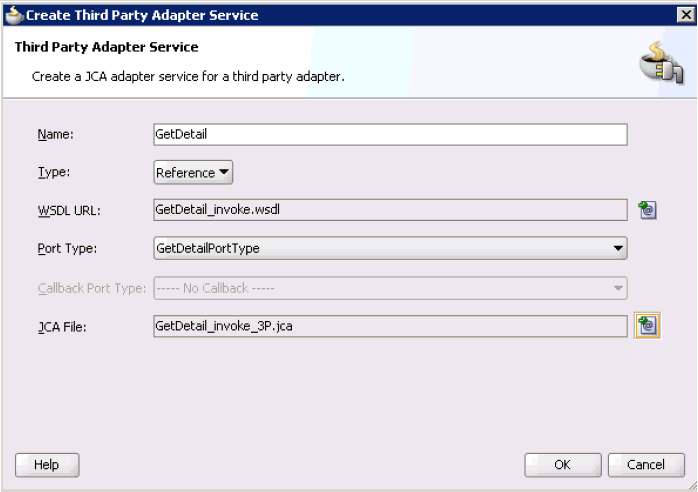
Description of the illustration bpel_out_adapt8.gif
-
Click OK.
The third party adapter service component (GetDetail) is created in the External References pane, as shown in the following image.
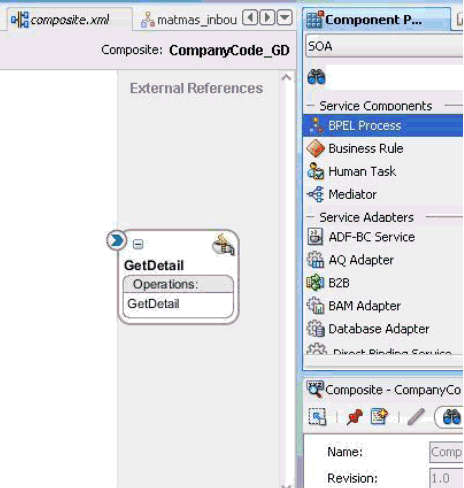
Description of the illustration bpel_out_adapt9.gif
You are now ready to configure an outbound BPEL process component.
Configuring an Outbound BPEL Process Component
Perform the following steps to configure an outbound BPEL process component:
-
Drag and drop the BPEL Process component from the Service Components pane to the Components pane.
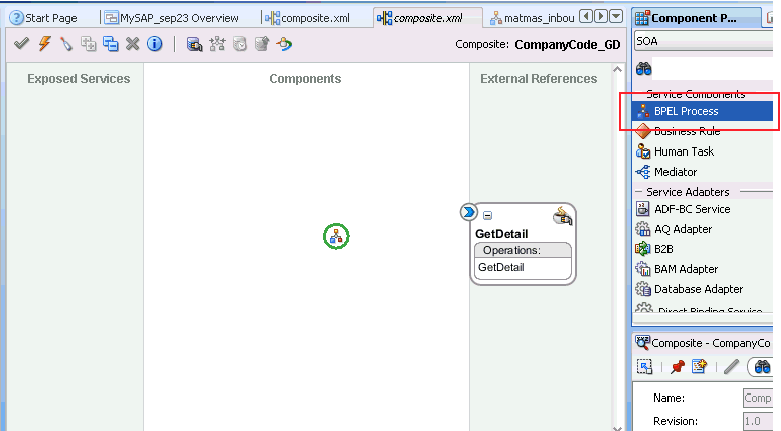
Description of the illustration bpel_out_proc1.gif
The Create BPEL Process dialog is displayed.
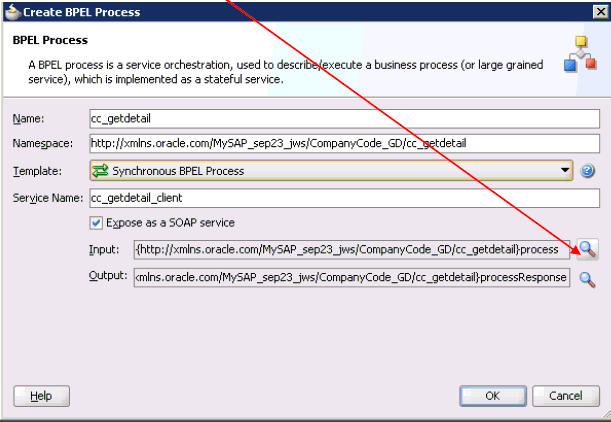
Description of the illustration bpel_out_proc2.gif
-
In the Name field, enter a name to identify the new outbound BPEL process component (for example, cc_getdetail).
-
From the Template list, select Synchronous BPEL Process.
-
Click the Browse icon, which is located to the right of the Input field to select the associated XML request schema file.
The Type Chooser dialog is displayed.
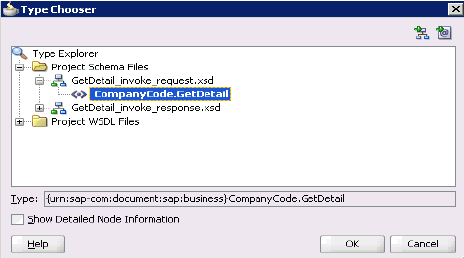
Description of the illustration bpel_out_proc3.gif
-
Expand Project Schema Files, GetDetail_invoke_request.xsd, and select CompanyCode.GetDetail.
-
Click OK.
You are returned to the Create BPEL Process dialog.
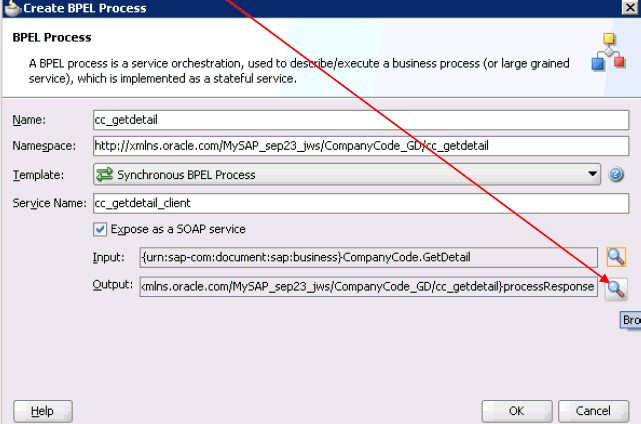
Description of the illustration bpel_out_proc4.gif
-
Click the Browse icon, which is located to the right of the Output field to select the associated XML response schema file.
The Type Chooser dialog is displayed.
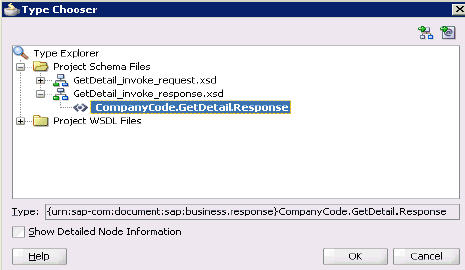
Description of the illustration bpel_out_proc5.gif
-
Expand Project Schema Files, GetDetail_invoke_response.xsd, and select CompanyCode.GetDetailResponse.
-
Click OK.
You are returned to the Create BPEL Process dialog.
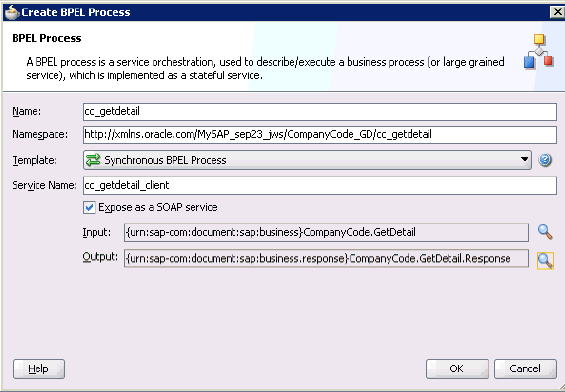
Description of the illustration bpel_out_proc6.gif
-
Click OK.
-
Create a connection between the outbound BPEL process component (cc_ getdetail) and the third party adapter service component (GetDetail).
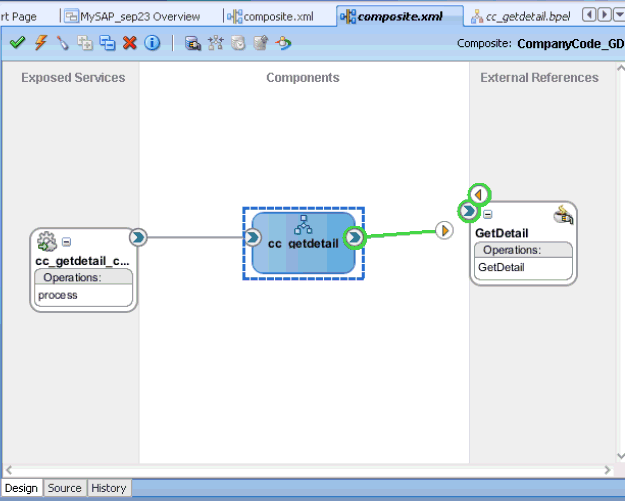
Description of the illustration bpel_out_proc7.gif
-
Double-click the outbound BPEL process component (cc_ getdetail) in the Components pane.

Description of the illustration bpel_out_proc8.gif
-
Drag and drop the Invoke activity component to the Components pane and place it between the receiveInput activity component and the replyOutput activity component.
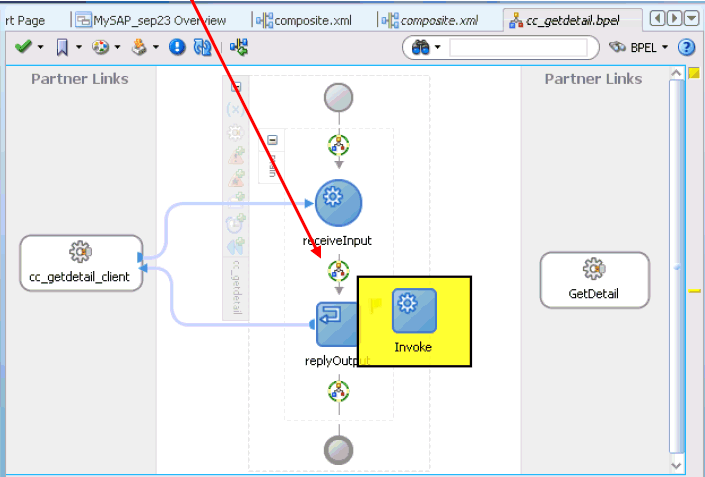
Description of the illustration bpel_out_proc9.gif
-
Create a connection between the new Invoke activity component (Invoke_1) and the third party adapter service component (GetDetail).

Description of the illustration bpel_out_proc10.gif
-
Double-click the new Invoke activity component (Invoke_1).
The Edit Invoke dialog is displayed.
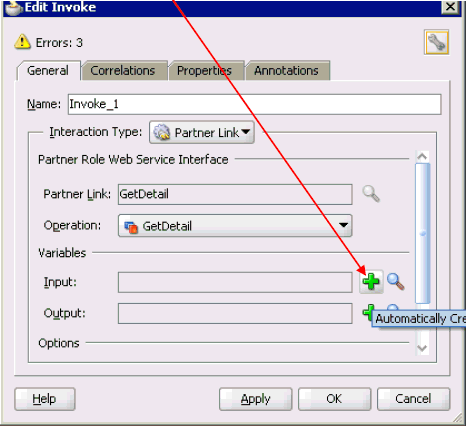
Description of the illustration bpel_out_proc11.gif
-
Click the Plus sign icon, which is located to the right of the Input field to configure a new input variable.
The Create Variable dialog is displayed.
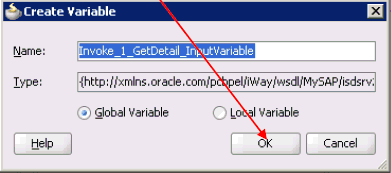
Description of the illustration bpel_out_proc12.gif
-
Accept the default values that are provided for the new input variable and click OK.
You are returned to the Edit Invoke dialog.
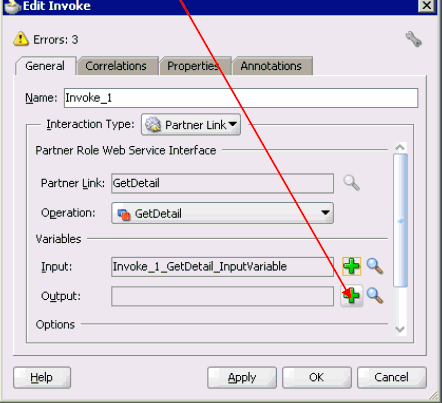
Description of the illustration bpel_out_proc13.gif
-
Click the Plus sign icon, which is located to the right of the Output field to configure a new output variable.
The Create Variable dialog is displayed.

Description of the illustration bpel_out_proc14.gif
-
Accept the default values that are provided for the new output variable and click OK.
You are returned to the Edit Invoke dialog.

Description of the illustration bpel_out_proc15.gif
-
Click Apply and then OK.
-
Drag and drop the Assign activity component to the Components pane and place it between the Receive activity component (receiveInput) and the Invoke activity component (Invoke_1).
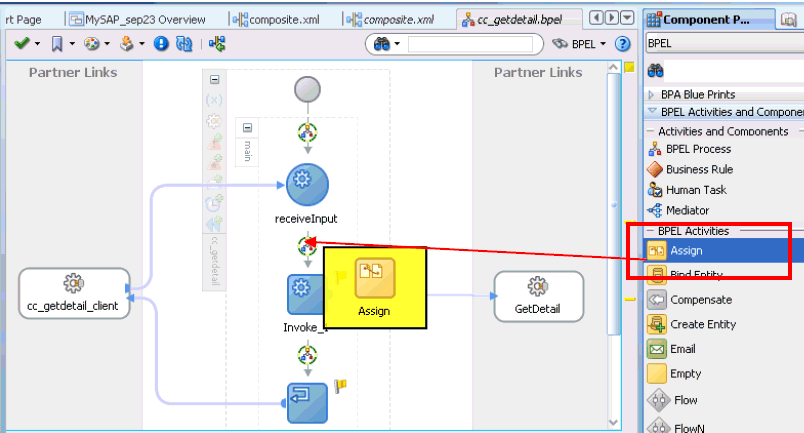
Description of the illustration bpel_out_proc16.gif
-
Double-click the new Assign activity component (Assign_1).
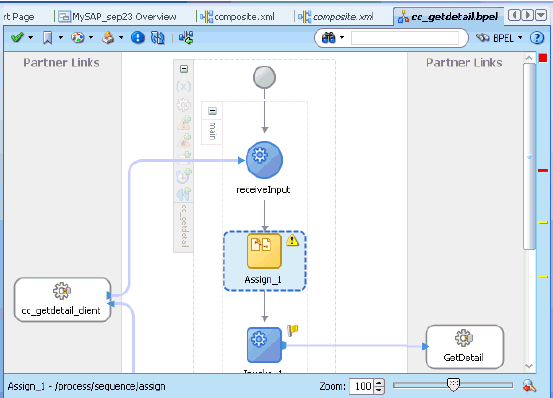
Description of the illustration bpel_out_proc17.gif
The Assign dialog is displayed.

Description of the illustration bpel_out_proc18.gif
-
Click the Copy Operation tab.
-
Click the Plus sign icon and select Copy Operation from the list of available operations.
The Create Copy Operation dialog is displayed.

Description of the illustration bpel_out_proc19.gif
-
In the From pane, expand Variables, InputVariable, and then select payload.
-
In the To pane, expand Variables, Invoke_1_GetDetail_InputVariable, and then select input_GetDetail.
-
Click OK.
You are returned to the Assign dialog.

Description of the illustration bpel_out_proc20.gif
-
Click Apply and then OK.
-
Drag and drop the Assign activity component to the Components pane and place it between the Invoke activity (Invoke_1) and the Reply activity (replyOutput).
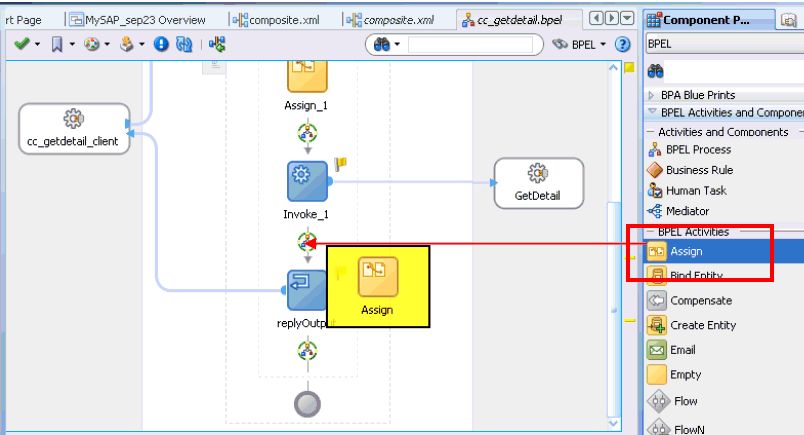
Description of the illustration bpel_out_proc21.gif
-
Double-click the new Assign activity component (Assign_2).
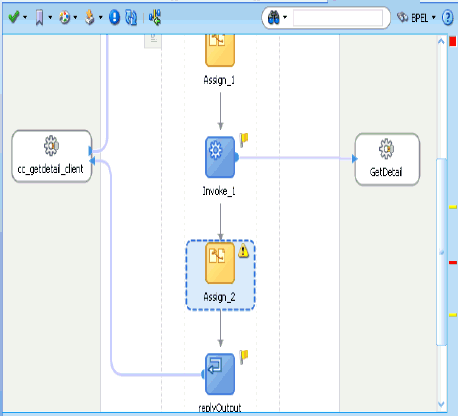
Description of the illustration bpel_out_proc22.gif
The Assign dialog is displayed.

Description of the illustration bpel_out_proc18.gif
-
Click the Copy Operation tab.
-
Click the Plus sign icon and select Copy Operation from the list of available operations.
The Create Copy Operation dialog is displayed.
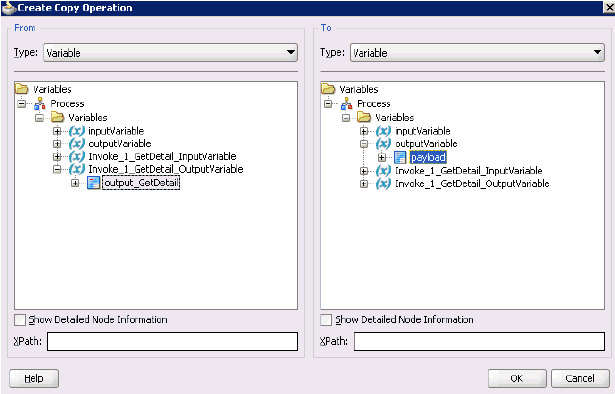
Description of the illustration bpel_out_proc23.gif
-
In the From pane, expand Variables, Invoke_1_GetDetail_OutputVariable, and then select output_GetDetail.
-
In the To pane, expand Variables, outputVariable, and then select payload.
-
Click OK.
You are returned to the Assign dialog.
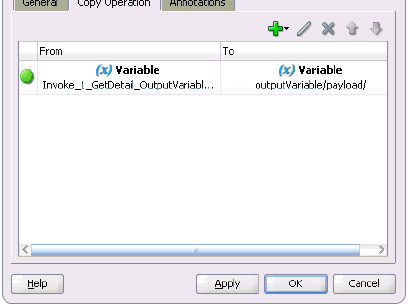
Description of the illustration bpel_out_proc24.gif
-
Click Apply and then OK.

Description of the illustration bpel_out_proc25.gif
-
Double-click composite.xml in the left pane.
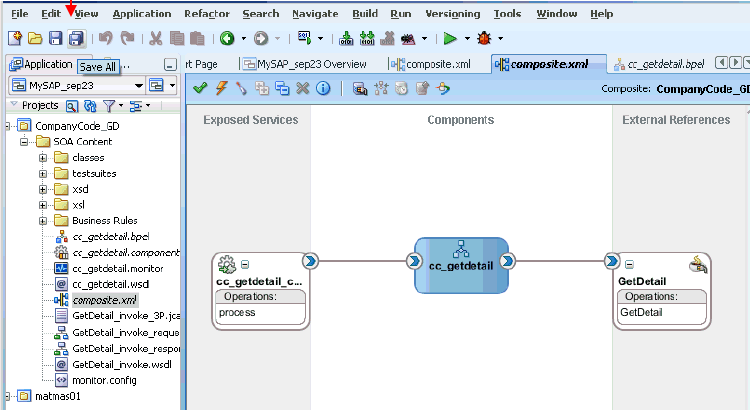
Description of the illustration bpel_out_proc26.gif
-
Click the Save All icon in the menu bar to save the new outbound BPEL process component that was configured.
You are now ready to deploy the BPEL outbound process.
Deploying the BPEL Outbound Process
Perform the following steps to deploy the BPEL outbound process.
-
Right-click the project name in the left pane (for example, CompanyCode_GD), select Deploy, and then click CompanyCode_GD.

Description of the illustration bpel_out_deploy1.gif
The Deployment Action page is displayed.

Description of the illustration bpel_out_deploy2.gif
-
Ensure that Deploy to Application Server is selected.
-
Click Next.
The Deploy Configuration page is displayed.

Description of the illustration bpel_out_deploy3.gif
-
Leave the default values selected and click Next.
The Select Server page is displayed.

Description of the illustration bpel_out_deploy4.gif
-
Select an available application server that was configured and click Next.
The SOA Servers page is displayed.

Description of the illustration bpel_out_deploy5.gif
-
Select a target SOA server and click Next.
The Summary page is displayed.

Description of the illustration bpel_out_deploy6.gif
-
Review and verify all the available deployment information for your project and click Finish.
The process is deployed successfully.
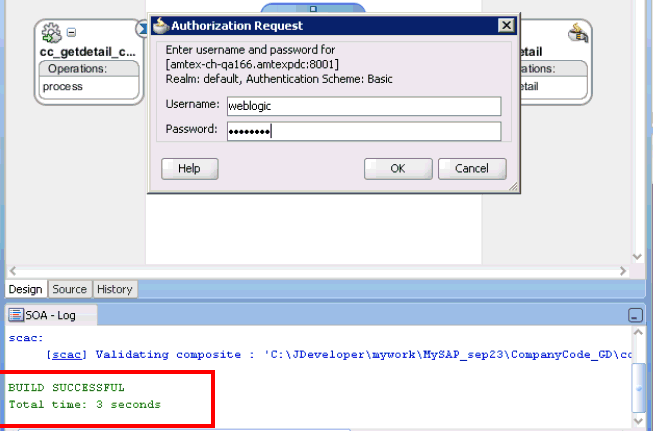
Description of the illustration bpel_out_deploy7.gif
If an Authorization Request dialog is displayed during the deployment process, provide the required user name and password and click OK.
Invoking the Input XML Document in the Oracle Enterprise Manager Console
Perform the following steps to invoke the input XML document in the Oracle Enterprise Manager console.
-
Logon to the Oracle Enterprise Manager console.
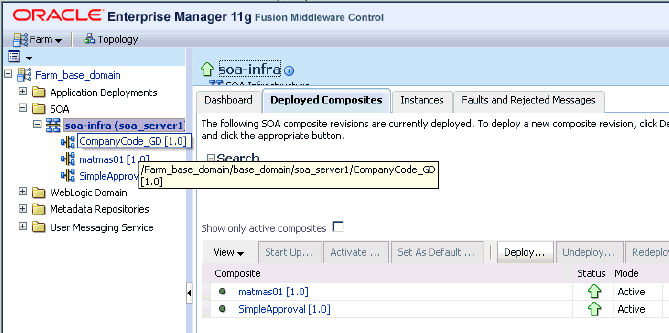
Description of the illustration bpel_out_invoke1.gif
-
Expand your domain in the left pane followed by the SOA folder.
-
Select an available project (for example, CompanyCode_GD).
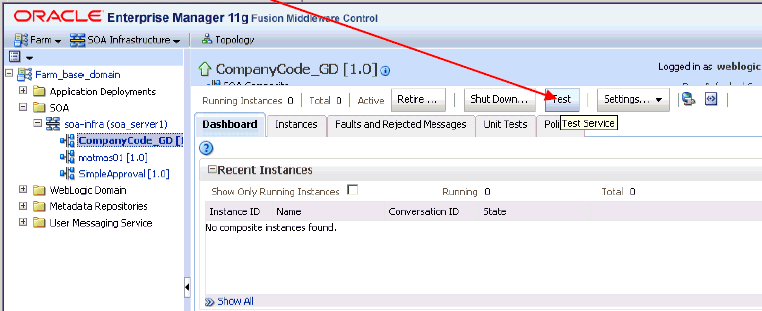
Description of the illustration bpel_out_invoke2.gif
-
Click Test.

Description of the illustration bpel_out_invoke3.gif
-
Click the Request tab.
-
Provide an appropriate input value in the Value field and click Test Web Service.
The output response is received in the Oracle Enterprise Manager console, as shown in the following image.
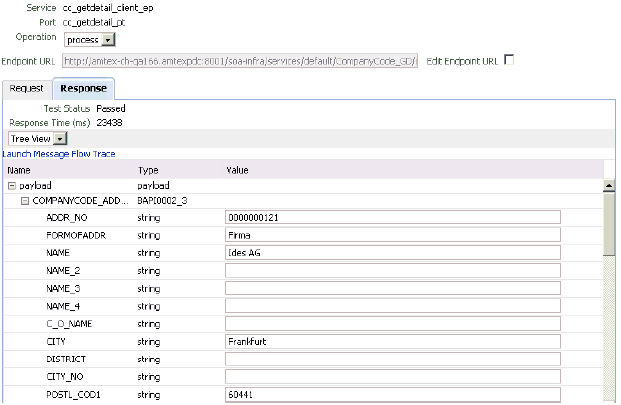
Description of the illustration bpel_out_invoke4.gif
Perform the following steps to invoke the input XML document using XML View:
-
Select XML View from the list.

Description of the illustration bpel_out_invoke5.gif
-
Provide an appropriate input XML document in the Input Arguments area and click Test Web Service.
The output response is received in the Oracle Enterprise Manager console, as shown in the following image.

Description of the illustration bpel_out_invoke6.gif
-
Testing Outbound BPEL and Mediator Processes
When testing an outbound BPEL process or an outbound Mediator process from the Oracle Enterprise Manager console, do not use the XML envelopes that are generated by these consoles. Instead, remove them and use the XML payloads that are generated from the schemas, which conform to the WSDLs for namespace qualifications.
The Mediator data flows can be tested using the Enterprise Manager console. When creating a Mediator data flow and interactions, the Web services are created and registered with the Oracle Application Server. For more information on creating a Mediator outbound process, see Chapter 6, "Integration With Mediator Service Components in the Oracle SOA Suite".
Designing an Inbound BPEL Process for Event Integration
This section demonstrates how Oracle Application Adapter for SAP R/3 integrates with SAP R/3 to receive event data. In this example, an SAP R/3 event occurs when a customer record is added to a SAP R/3 system.
The following tools are required to complete your adapter design-time configuration:
-
Oracle Adapter Application Explorer (Application Explorer)
-
Oracle JDeveloper BPEL Designer (JDeveloper) or Eclipse
Note:
The examples in this chapter demonstrate the use of JDeveloper.Before you design a BPEL process, you must generate the respective WSDL file using Application Explorer. See "Generating WSDL for Event Integration" for more information.
Generating WSDL for Event Integration
You must create a separate channel for every inbound J2CA service and select that channel when you generate WSDL for inbound interaction using Application Explorer.
Note:
If two or more events share the same channel, event messages may not be delivered to the right BPEL process.To create a channel:
-
Start Application Explorer and connect to a J2CA configuration.
-
In the left pane, expand the Events node.
-
Expand the MySAP node.
The Ports and Channels nodes appear in the left pane.
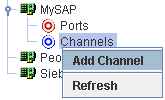
Description of the illustration addchannel.gif
-
Right-click Channels and select Add Channel.
The Add Channel dialog is displayed.
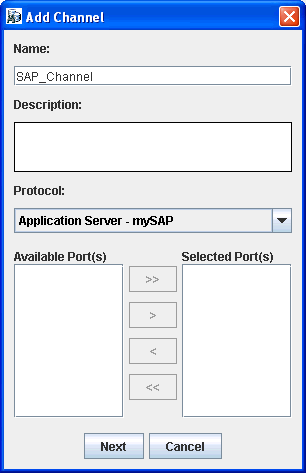
Description of the illustration addchanneldialog.gif
Perform the following steps:
-
Enter a name for the channel, for example,
SAP_Channel. -
Enter a brief description (optional).
-
From the Protocol list, select Application Server - mySAP.
-
-
Click Next.
The Application Server dialog is displayed. The following tabs are available:
-
User (Required)
-
System (Required)
-
Security
-
Advanced

Description of the illustration channelsystemtab.gif
-
-
For the User tab, enter the appropriate information for your SAP R/3 channel based on the information in the following table.
Target Parameter Description Client
The client number defined for the SAP R/3 application for client communications.
User
A valid user ID for the SAP R/3 application.
Password
A valid password for the SAP R/3 application.
Authentication Mode
The authentication mode you want to use when connecting to your SAP R/3 system. By default, Password is selected from the list.
-
Click the System tab.
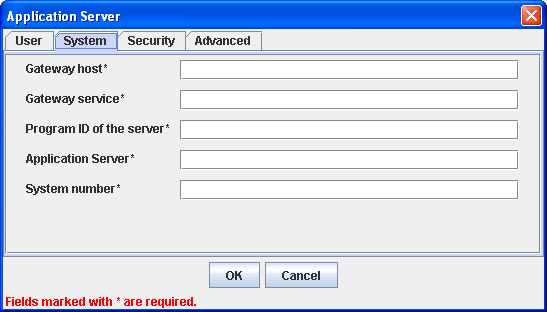
Description of the illustration channelusertab.gif
-
For the System tab, enter the appropriate information for your SAP R/3 channel based on the information in the following table.
Table 5-2 System Tab Parameters
Target Parameter Description Gateway host
A host name for the SAP R/3 Gateway.
Gateway service
A service for the SAP R/3 Gateway.
Program ID of the server
An SAP R/3 program ID you want to use for this channel.
Application Server
The name of the SAP R/3 application server you are using.
System Number
An SAP R/3 system number.
-
For the Security tab (optional), enter the appropriate information for your SAP R/3 channel based on the information in the following table.
Table 5-3 Security Tab Parameters
Target Parameter Description SNC mode
By default, SNC is disabled. To enable SNC, select 1 from the list.
SNC partner
Enter the name of the RFC server or message server (load balancing) that provides the SNC services.
SNC level
From the list select the version of the SNC library.
SNC name
Enter the name of the SNC library you are using.
SNC library path
-
For the Advanced tab (optional), enter the appropriate information for your SAP R/3 channel based on the information in the following table.
Table 5-4 Advanced Tab Parameters
Target Parameter Description IDOC Format
Select an IDOC type from the list:
-
XML (default)
-
XML-CDATA-ENVELOPED
-
NATIVE IDOC
IDOC release
The IDOC versioning you want to use for your connection.
IDOC release provider
The IDOC release provider for your connection. Select IDOC DOCREL field (default), SAP release, or user input from the list.
SAP trace
Select this option to enable SAP traces.
The SAP traces are stored in the following locations during design time and run time:
Design Time:
C:\oracle\Middleware\home_GA\Oracle_SOA1\soa\thirdparty\ApplicationAdapters\tools\iwae\bin
Run Time:
C:\oracle\Middleware\home_GA\user_projects\domains\base_domain
The file name formats that are used for the SAP traces are as follows (for design time and run time):
-
rfc02664_04332.trc
-
JCO100226_043846994.trc
Processing Mode
Select the type of synchronous processing from the list. Possible values include REQUEST and REQUEST_RESPONSE.
-
-
Click OK.
The channel appears under the channels node in the left pane. An X over the icon indicates that the channel is currently disconnected.
Generating WSDL for Event Notification
After you create a channel and verify that it is not started, you must generate WSDL for the event using Application Explorer.
-
Start Application Explorer.
-
A list of all adapters is displayed.

Description of the illustration adapterexpandedpartial.gif
Perform the following steps:
-
Expand the MySAP node.
A list of your available targets is displayed.

Description of the illustration connect1.gif
-
Click a target name under the MySAP node, for example, SAPTarget..
-
-
Verify your connection parameters.
-
Provide the required password.
-
Right-click the target name and select Connect.
The x icon disappears, indicating that the node is connected.

Description of the illustration saptarget2.gif
-
Expand the IDOCs node and select DEBMAS.
The DEBMAS list is displayed.

Description of the illustration selectdebmas.gif
-
Right-click DEBMAS05 from the DEBMAS list.

Description of the illustration bpel_38a.gif
-
Select Create Inbound JCA Service (Event).
The Export WSDL dialog is displayed.
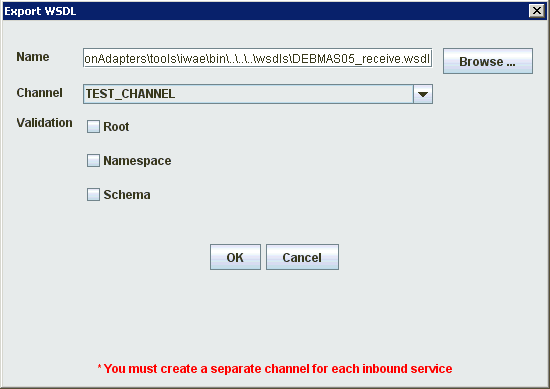
Description of the illustration bpel_39_11g.gif
Perform the following steps:
-
In the Name field, specify a name for the WSDL file.
-
From the Channel list, select the channel you created for this inbound service.
Important: You must create a separate channel for every event. Verify that the channel is stopped before run-time.
-
Three check boxes for Root, Namespace, and Schema validation are also available. Selection of multiple validation options is allowed.
- Root validation is used to validate the root element in the inbound XML document.
- Namespace validation is used to validate the namespace in the inbound XML document.
- Schema validation is used to validate the inbound XML document with the schema in the WSDL document.
During run time, validation is processed based on the validation options that are selected. If multiple validation options are selected, during run time if the first validation option fails, the remaining validation options are not processed. Root and namespace validations are considered modest levels of validation. Schema validation is a stricter validation level. It is recommended to use root and namespace validation options, unless the root element and namespace are different between the IDOCs in the SAP environment.
-
-
You can now create an empty composite for SOA, which is the first step that is required to define a BPEL inbound process in JDeveloper.
Creating an Empty Composite for SOA
Perform the following steps to create an empty composite for SOA:
-
Create a new SOA application.
-
Enter name for the new SOA Application and click Next.

Description of the illustration bpel_out_comp1.gif
The Name your project page is displayed.
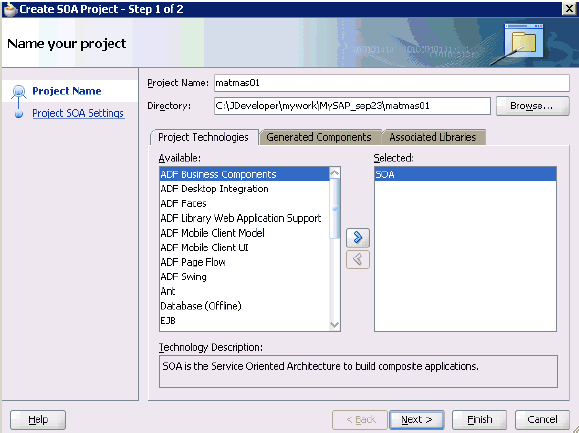
Description of the illustration bpel_in_comp1.gif
-
Enter a project name (for example, matmas01) and click Next.
The Configure SOA settings page is displayed.

Description of the illustration bpel_in_comp2.gif
-
From the Composite Template list, select Empty Composite and click Finish.
Defining a BPEL Inbound Process
This section describes how to define a BPEL inbound process, which consists of the following stages:
-
Configuring a Third Party Adapter Service Component
-
Configuring an Inbound BPEL Process Component
Creating a Third Party Adapter Service Component
Perform the following steps to create a third party adapter service component:
-
Drag and drop the Third Party Adapter component from the Service Adapters pane to the Exposed Services pane.
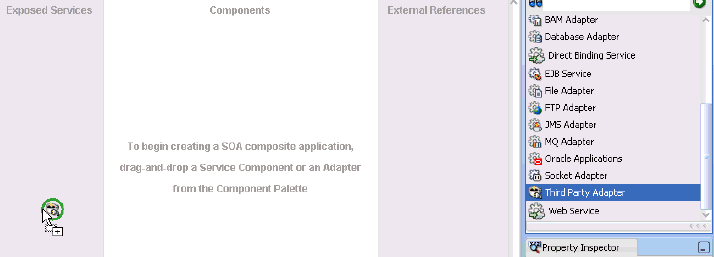
Description of the illustration bpel_in_adapt.gif
The Create Third Party Adapter Service dialog is displayed.
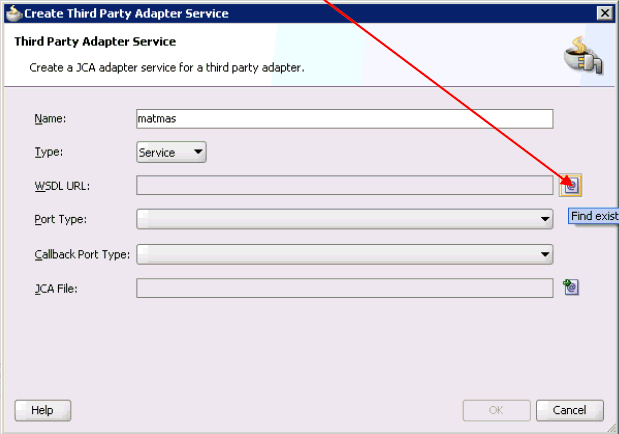
Description of the illustration bpel_in_adapt1.gif
-
Enter a name for the third party adapter service.
-
Ensure that Service is selected from the Type list (default).
-
Click the Find existing WSDLs icon, which is located to the right of the WSDL URL field.
The SOA Resource Browser dialog is displayed.
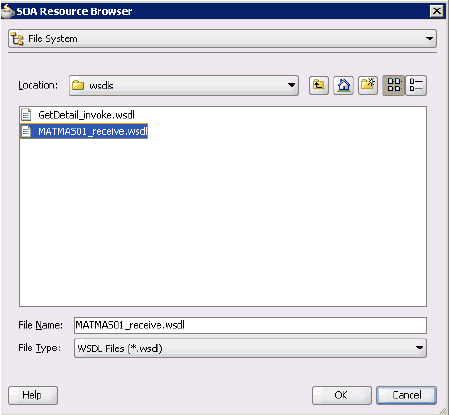
Description of the illustration bpel_in_adapt2.gif
-
Browse and select an inbound WSDL file from the following directory:
C:\oracle\Middleware\home_GA\Oracle_SOA1\soa\thirdparty\ApplicationAdapters\wsdls
-
Click OK.
The Localize Files dialog is displayed.

Description of the illustration bpel_in_adapt3.gif
-
Click OK.
The inbound WSDL file and associated receive/request XML schema file (.xsd) are imported to the project folder that has been created.
You are returned to the Create Third Party Adapter Service dialog.

Description of the illustration bpel_in_adapt4.gif
-
Click the Find JCA file icon, which is located to the right of the JCA File field.
The SOA Resource Browser dialog is displayed.
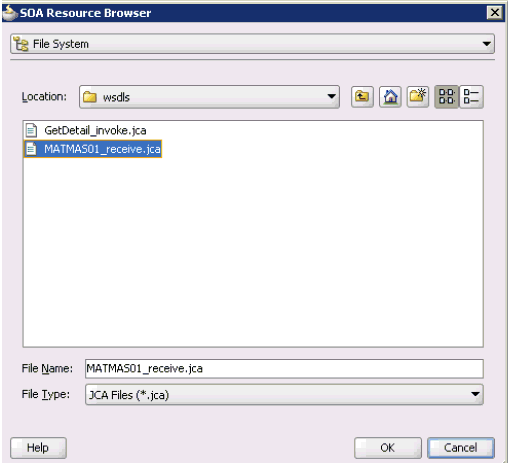
Description of the illustration bpel_in_adapt5.gif
-
Browse and select the JCA properties file from the following directory:
C:\oracle\Middleware\home_GA\Oracle_SOA1\soa\thirdparty\ApplicationAdapters\wsdls
-
Click OK.
The following message is displayed.

Description of the illustration bpel_in_adapt6.gif
-
Click Yes.
A copy of the JCA properties file is made in the project folder.
You are returned to the Create Third Party Adapter Service dialog.
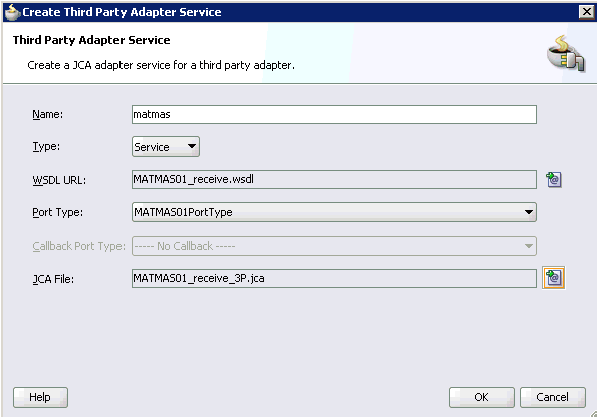
Description of the illustration bpel_in_adapt7.gif
-
Click OK.
The third party adapter service component (matmas) is created in the Exposed Services pane, as shown in the following image.

Description of the illustration bpel_in_adapt8.gif
You are now ready to configure an inbound BPEL process component.
Creating an Inbound BPEL Process Component
Perform the following steps to create an inbound BPEL process component:
-
Drag and drop the BPEL Process component from the Service Components pane to the Components pane.
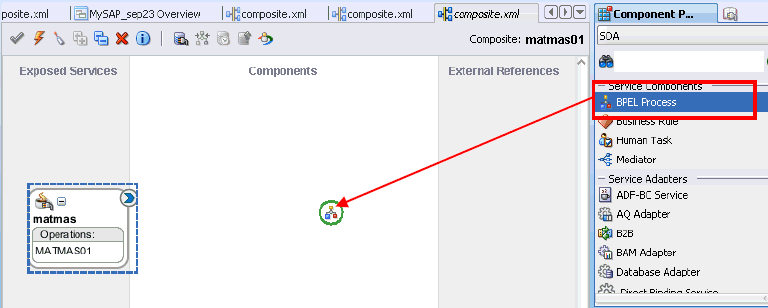
Description of the illustration bpel_in_proc1.gif
The Create BPEL Process dialog is displayed.
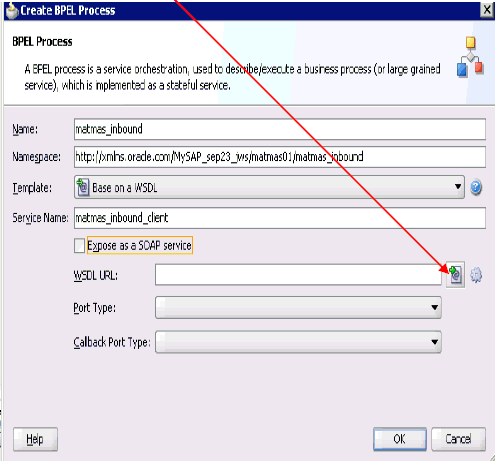
Description of the illustration bpel_in_proc2.gif
-
In the Name field, enter a name to identify the new inbound BPEL process component (for example, matmas_inbound).
-
From the Template list, select Base on a WSDL.
-
Uncheck the Expose as SOAP service check box.
-
Click the Find existing WSDLs icon, which is located to the right of the WSDL URL field.
The SOA Resource Browser dialog is displayed.
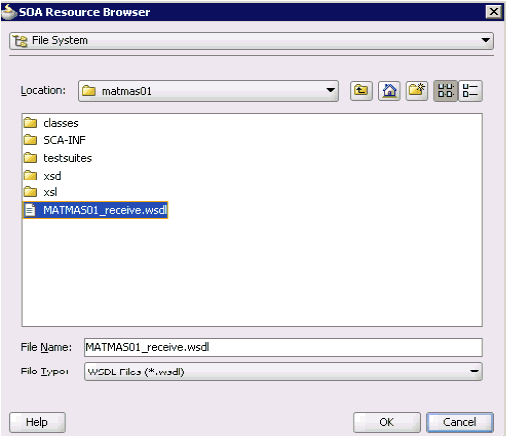
Description of the illustration bpel_in_proc3.gif
-
Browse and select an inbound WSDL file from the project folder.
For example:
C:\JDeveloper\mywork\MySAP_sep23\matmas01\MATMAS01_receive.wsdl
-
Click OK.
You are returned to the Create BPEL Process dialog.
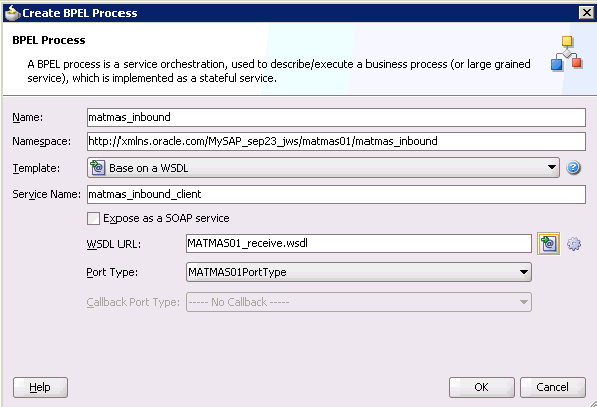
Description of the illustration bpel_in_proc4.gif
-
Click OK.
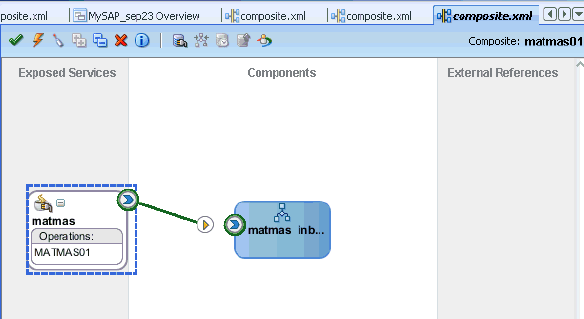
Description of the illustration bpel_in_proc5.gif
-
Create a connection between the third party adapter service component (matmas) and the inbound BPEL process component (matmas_inbound).
-
Double-click composite.xml in the left pane.
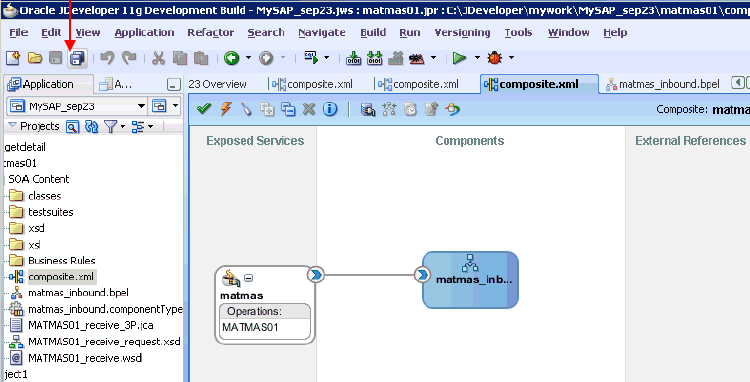
Description of the illustration bpel_in_proc6.gif
-
Click the Save All icon in the menu bar to save the new inbound BPEL process component that was configured.
You are now ready to deploy the BPEL inbound process.
Deploying the BPEL Inbound Process
Perform the following steps to deploy the BPEL inbound process.
-
Right-click the project name in the left pane (for example, matmas01), select Deploy, and click matmas01.
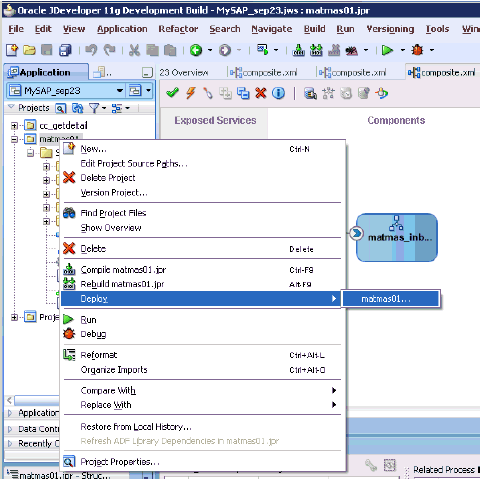
Description of the illustration bpel_in_deploy1.gif
The Deployment Action page is displayed.
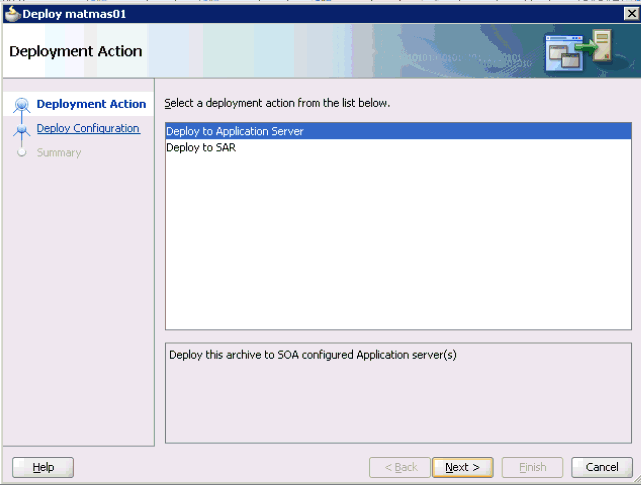
Description of the illustration bpel_in_deploy2.gif
-
Ensure that Deploy to Application Server is selected.
-
Click Next.
The Deploy Configuration page is displayed.
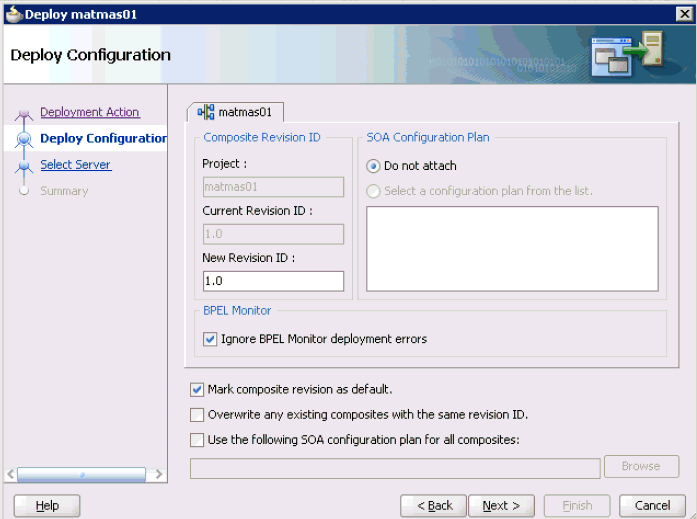
Description of the illustration bpel_in_deploy3.gif
-
Leave the default values selected and click Next.
The Select Server page is displayed.

Description of the illustration bpel_in_deploy4.gif
-
Select an available application server that was configured and click Next.
The SOA Servers page is displayed.

Description of the illustration bpel_in_deploy5.gif
-
Select a target SOA server and click Next.
The Summary page is displayed.

Description of the illustration bpel_in_deploy6.gif
-
Review and verify all the available deployment information for your project and click Finish.
The process is deployed successfully.
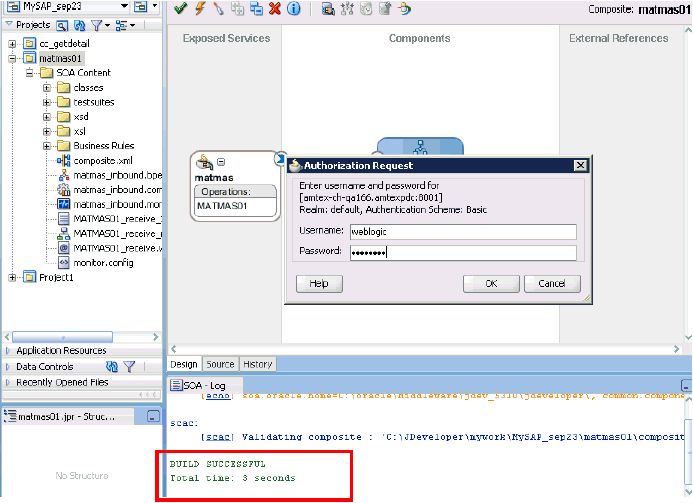
Description of the illustration bpel_in_deploy7.gif
If an Authorization Request dialog is displayed during the deployment process, provide the required user name and password and click OK.
Once event messages are triggered through SAP GUI, successful instances are received in the Oracle Enterprise Manager console.
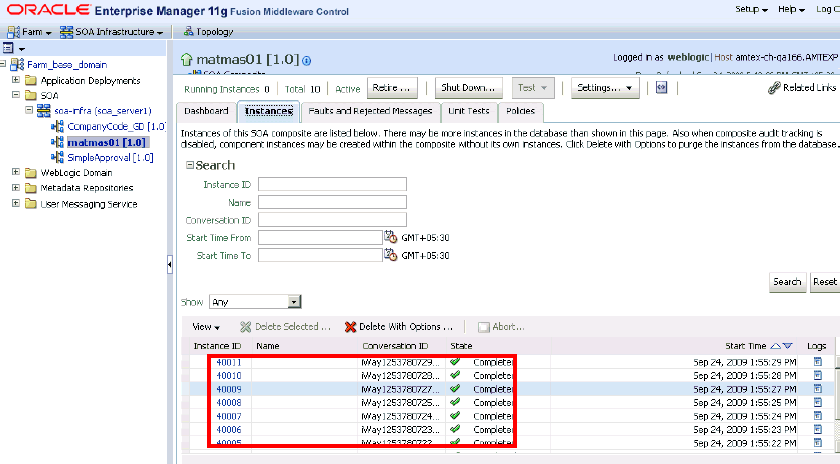
Description of the illustration bpel_in_deploy8.gif
Triggering an Event in SAP R/3
Events are generated by activity in an application system. For example, SAP R/3 may generate an event as customer information is updated in the system. For more information on events, see "Configuring an Event Adapter"
The following topics describe how to trigger an event in SAP R/3 and verify event integration using Oracle Application Adapter for SAP R/3.
To trigger an event in SAP R/3:
-
Start the SAP Workbench and log in to the SAP R/3 system.

Description of the illustration image032.gif
-

Description of the illustration image034.gif
Enter the following information in the Send Customers window:
-
In the Customer field, enter a customer number with a range from 1 to 3.
-
In the Output type field, enter DEBMAS.
-
In the Logical system field, specify the logical system you are using with SAP R/3.
-
-
Click the check mark icon in the upper left-hand corner.

Description of the illustration image036.gif
-
Ensure DEBMAS appears in the Message type column.
-
Click the Execute button.
Customer master data is sent to the logical system specified. If a channel in Application Explorer defined the Program ID with the same value, the channel receives this customer master data from SAP R/3.
To verify your results:
-
Logon to the Oracle Enterprise Manager console by using the following URL:
http://localhost:7001/em
-
Expand your domain in the left pane followed by the SOA folder.
-
Select an available inbound BPEL process (for example, matmas01).

Description of the illustration verify_results1.gif
-
Click the Instances tab.
Recently received run-time event messages are displayed in the Instances tab.
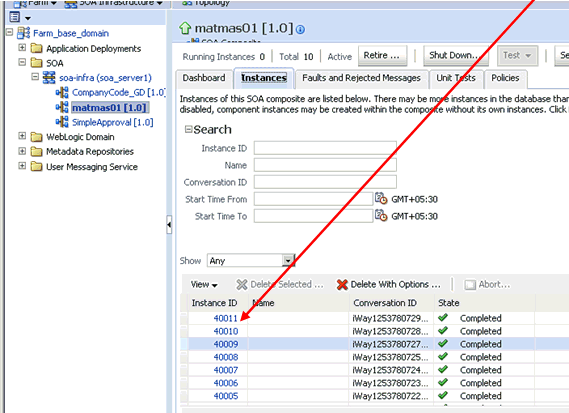
Description of the illustration verify_results2.gif
-
Click the Instance ID to view the received event message.